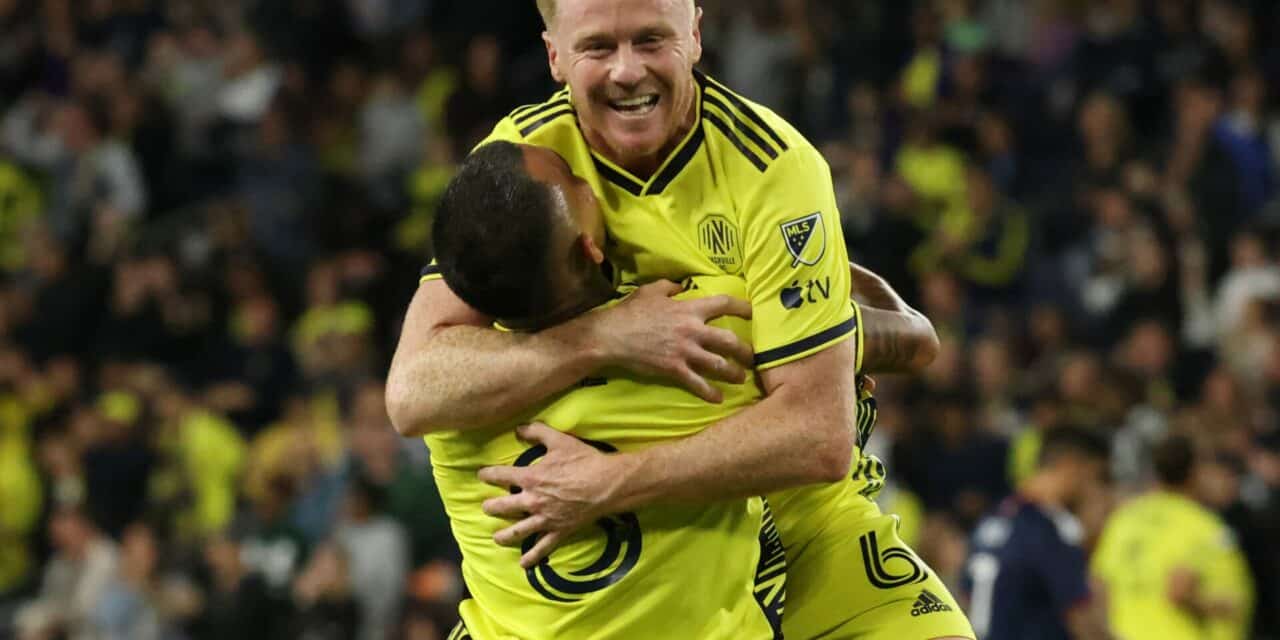PITCH PERFECT: Nashville SC midfielder Dax McCarty celebrates after scoring a goal at Geodis Park on Oct. 14. (Getty Images)
There aren’t many players more qualified to speak on the evolution of American soccer facilities than Dax McCarty.
The Nashville SC midfielder has played nearly 500 games in Major League Soccer since making his debut for FC Dallas in 2006.
In between Dallas and Nashville, he had runs with DC United, the New York Red Bulls and the Chicago Fire.
The 37-year-old’s remarkable 18th MLS season concluded with a playoff loss to Orlando City, with NSC losing both games 1-0. The MLS playoffs, broadcast for the first time on Apple TV+, culminate in the final Dec. 9.
It was a heartbreaking end to a season that saw Nashville — and its 2-year-old Populous-designed home ground, Geodis Park, the largest soccer-specific stadium in the U.S. — in the spotlight when the team reached its first final. Inter Miami and its Argentine superstar Lionel Messi came to Music City for the Leagues Cup final, a wild affair won by Inter Miami after 11 rounds of a penalty shootout.
Not the result McCarty was looking for, but certainly another milestone on a soccer journey that began in Winter Park, Florida. Like many players of his vintage, McCarty sees the growth of his sport in the U.S. as almost unfathomable.
“When I was growing up, it was difficult to get soccer fields to train on. The only fields I played on were football fields,” he said. “You got the feeling that football and track coaches were annoyed. ‘This isn’t a real sport. What are you doing here?’ Now, it’s not just that there’s soccer-specific venues. We have sold-out stadiums and fervent fan support. There’s tailgating. It’s a pinch-yourself-type of moment if you think about where it was.”
McCarty’s debut came in an era when MLS moved from merely actively encouraging its teams to play in soccer-specific stadia, but began requiring expansion teams (for the most part) to play in soccer-only facilities.
“I never enjoyed playing in football stadiums, if I’m being honest,” McCarty says. “The actual pitch, it never felt right. The pitches were uneven and difficult to predict. There was also a cavernous feeling in an 80,000-seat stadium, even with the loudest fans.”
That different sports have different demands for their fields isn’t a big secret, and McCarty, whose legendary longevity and reliability would be imperiled if he’d had to rehab a knee injured by taking a bad step on a shoddy pitch, gushes at the increased expertise he’s seen in his career from grounds crews.
“It’s night and day. Groundskeepers are so much better than they used to be and there’s so much more investment in pitches,” he said. “Nobody wants to watch guys not able to string passes together because there’s sand or potholes.”
While Messi, and David Beckham and Zlatan Ibrahimovic before him, is evidence that the league can compete for the world’s top players (particularly if those players are interested in lucrative endorsements that come from playing in the world’s most robust economy), McCarty says the commitment to improved and dedicated soccer infrastructure is the best way for the MLS to draw elite players from the top leagues in Europe and, now, Saudi Arabia.
As may be expected for a player who has been in the league for nearly two decades, it’s difficult for McCarty to limit his list of favorite grounds. Beyond his home stadium of Geodis Park, he named three other favorites.
First, Portland’s Providence Park, which has existed in some form since the 1890s, primarily as a baseball stadium.
“Portland is unique. It’s a reinvented, refurbished baseball stadium. They manufactured the Timbers Army into a massive standing-room only area behind the goal,” he says, something other MLS teams have copied. A feature McCarty is thankful other teams haven’t copied from Portland: an artificial playing surface.
McCarty also lauded New York Red Bulls’ Red Bull Arena. “It’s a traditional, old-school stadium. The design of the stadium is almost European. The locker rooms are on either side of the field and you walk right into the field,” he says.
Finally, he points to Sporting KC’s Children’s Mercy Park, elements of which he sees borrowed and reinterpreted at Geodis. “It’s a smaller market and It’s a perfectly executed design. It’s a great atmosphere when the fans are engaged,” he says.
MLS, at less than 30 years old and now valued at more than $16 billion according to Sportico, is one of the youngest leagues in the world’s most popular sport, a sport with a host of legendary teams and legendary stadiums, brimming with history and culture that can be intimidating for an upstart. But McCarty says Americans’ embrace of the sport, and the MLS’s investment in it, lays the foundation for its stadiums to join the ranks of the legends.
“It’s a matter of time,” he says. “We’ll probably see those teams with older stadiums come and look at MLS stadiums at what they want their new stadiums to look like.”







